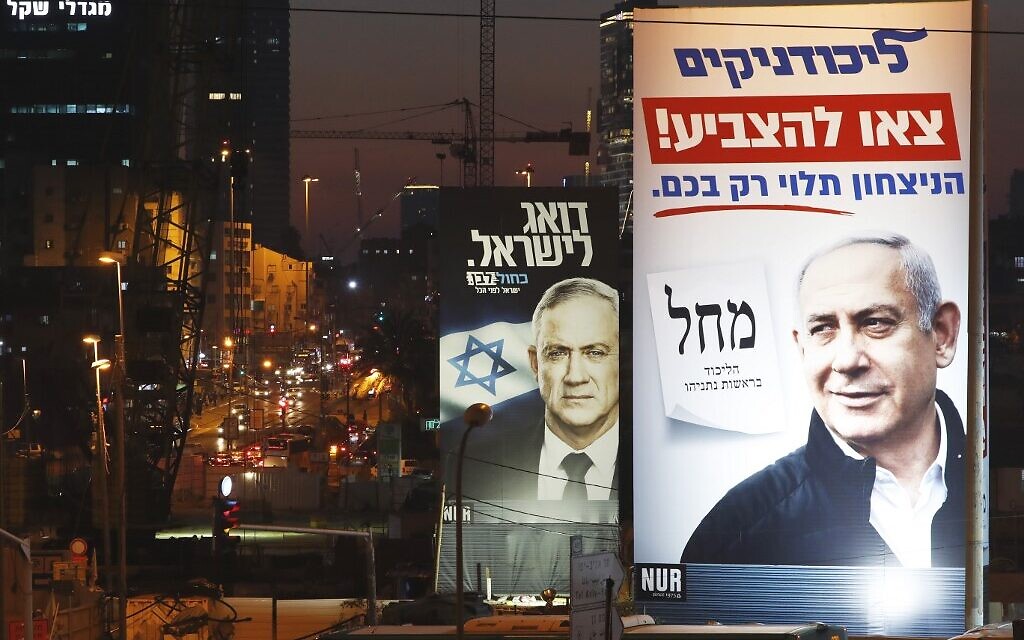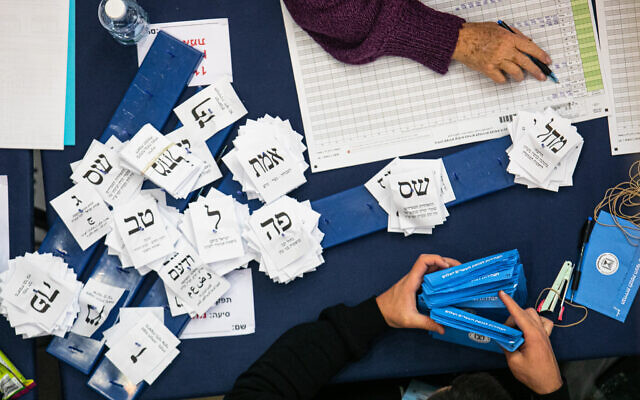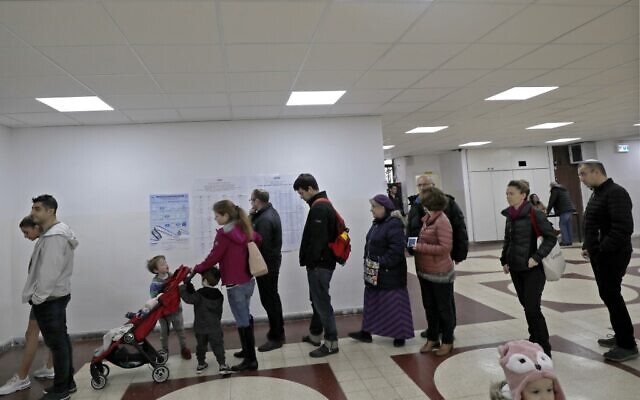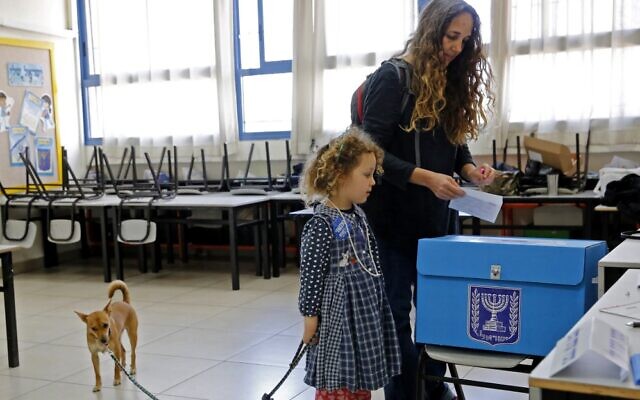Results highlight geographical polarization, with some parts of the country giving a clear lead to PM’s party and others opting, albeit underwhelmingly, for its centrist rival

On election day in April and September 2019, Prime Minister Benjamin Netanyahu dedicated most of the day to warning of pending losses for Likud, repeatedly claiming that turnout was low in traditional strongholds for the ruling party while areas supporting the rival Blue and White were seeing a surge of voters.
This time, during Monday’s vote, he did not employ the same “gevalt” campaign, at least not with the intensity of the previous two election days. But with just two hours to go before voting ended, he did put out a very specific “emergency update” tweet claiming that turnout was low in six Likud bastions — Eilat, Tiberias, Netanya, Migal Ha’emek, Kiryat Gat and Kiryat Ata — urging “Likudniks” to “go out and vote now!”
A look at the “almost final” results put out by the Central Elections Committee on Wednesday, particularly in these six towns, shows a trend that may help to explain the turnaround from the last election, when Blue and White overtook Likud.
The committee said that with 99.85% of the votes tallied — with the exception of “double envelope” votes from soldiers, diplomats, hospital patients and prisoners and those from the 25 (of the over 10,000) polling booths where irregular activities had been recorded on election day — Likud maintains a three-seat lead over Blue and White.

The almost-final results give Likud a total of 36 seats to Blue and White’s 33; third is the Joint List alliance of Arab-majority parties at 15; followed by the ultra-Orthodox party Shas with nine; then United Torah Judaism, Avigdor Liberman’s Yisrael Beytenu and Labor-Gesher-Meretz with seven each; rounding out the list is Yamina with six.
According to these results, the right-wing religious bloc of Likud and parties supporting Netanyahu rose from 55 to 58 seats, with the center-left bloc, including the predominantly Arab Joint List — which has never been a member of the government — dropping from 57 seats to 55.
While a look at the breakdown of the 4,577,498 total votes (so far) shows strong divisions between geographical areas, with some parts of the country giving a big lead to Likud and others clearly opting for Blue and White, a closer review of results by municipality shows a significantly higher turnout for many towns and cities that swung right compared with the results from September.
The general polarization can be clearly seen in the results for Tel Aviv compared to Jerusalem.
In Jerusalem, Likud came first with 27.8% of the vote (and the large ultra-Orthodox community pushing the United Torah Judaism party to second place with 24.2%). Blue and White, on the other hand, won just 12.5% of the total votes in the capital. The coastal city of Tel Aviv, on the other hand, with its young, liberal voter base, gave centrist Blue and White a resounding 48.2% percent of the vote, while Likud came in second with 21.8% (ahead of the left-wing Labor-Gesher-Meretz party, which scored 14.5%).

In fact, Blue and White outdid Likud in most of the central Israeli towns surrounding Tel Aviv, while the ruling party held strong primarily in the south of the country. In the north, a similar pattern can be seen with Gantz’s party winning big in the Haifa metropolis while Netanyahu’s swept many of the smaller “periphery” towns.
In the central Israeli town of Givatayim, for example, Blue and White won 55.5% of the vote while Likud got 20.3%. In Modiin, Blue and White was at 45.5% and Likud at 28.7%. In Herzliya, Blue and White came out on top with 51.4% while Likud scored 27.1%. In Ramat Gan, Blue and White got 46.6% of the vote compared to Likud’s 28.6%.
But a comparison between the results of September’s election, in which Blue and White outdid Likud overall by scoring 33 seats to the ruling party’s 32, shows that almost across the board Blue and White failed to boost its votes by any significant amount in these towns, if at all, whereas Likud succeeded in doing so.
A particularly telling point of comparison can be seen in the few central towns that saw very close races between Likud and Blue and White in both races.
In September, for example, Rishon Lezion saw Likud gain 33.9%, just behind Blue and White’s 36.6%; this time around, Likud overtook Blue and White, going up to 40.2%, while Benny Gantz’s party got 36.9%.

In Rosh Ha’ayin, Gantz’s hometown, Blue and White led Likud in September by just a handful of ballots with 34.7% to Likud’s 34.6%. This time, Likud went up to 40.2%, overtaking Blue and White’s 35.1%.
Crucially, in most Likud strongholds, the party outdid Blue and White by significantly larger margins than those that it was beaten with in the center of the country.
In Beersheba, “the capital of the Negev,” Likud scored 43.4% in September while Blue and White came in second with 18.8%. On Monday, Likud soared nearly seven points to 50.1% while Blue and White stalled at 18.1%.
In the coastal cities of Ashkelon and Ashdod, Likud gained 40.5% and 31.2%, respectively in September, while Blue and White was in both cases pushed to third place with 17.3% and 16.3%, behind Yisrael Beytenu (18.3% and 18%). This time, Likud climbed eight points to 48.1% in Ashkelon (with Blue and White dropping to 1.16%) and five points to 36.6% in Ashdod (with Blue and White dropping to 16.5).
In the Gaza border town of Sderot, frequently targeted by rockets, the prime minister’s party went from 42.1% in September to 51.2%, whereas Blue and White remained relatively stagnant, dropping from 12.3% to 11.5%.
The Likud gains, compared to September, can be clearly viewed in the six towns targeted by Netanyahu in his election day tweet: In Eilat the party went from 42.9% to 49.7%; in Tiberias from 45.8% to 51%; Netanya saw the party rise from 35.9% to 43.1%; Migal HaEmek saw a boost from 39.5% to 45.3%; Kiryat Gat went from 37.2% to 45.7%; and in Kiryat Ata Likud scored 50.7% compared with 43.9% in September.
As reported by The Times of Israel
